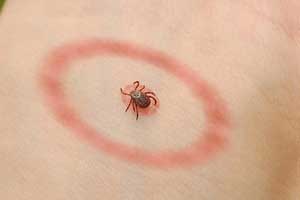- Home
- Editorial
- News
- Practice Guidelines
- Anesthesiology Guidelines
- Cancer Guidelines
- Cardiac Sciences Guidelines
- Critical Care Guidelines
- Dentistry Guidelines
- Dermatology Guidelines
- Diabetes and Endo Guidelines
- Diagnostics Guidelines
- ENT Guidelines
- Featured Practice Guidelines
- Gastroenterology Guidelines
- Geriatrics Guidelines
- Medicine Guidelines
- Nephrology Guidelines
- Neurosciences Guidelines
- Obs and Gynae Guidelines
- Ophthalmology Guidelines
- Orthopaedics Guidelines
- Paediatrics Guidelines
- Psychiatry Guidelines
- Pulmonology Guidelines
- Radiology Guidelines
- Surgery Guidelines
- Urology Guidelines
Scientists develop new quick test for diagnosing Lyme disease within minutes

Scientists have developed new quick test for diagnosing Lyme disease within minutes. At present testing for Lyme disease takes a few hours to carry out the test and its interpretation. A team led by Sam Sia, professor of biomedical engineering at Columbia Engineering, has developed a rapid microfluidic test that can detect Lyme disease with similar performance as the STT in a much shorter time -- 15 minutes. The findings of the research have been published today in the Journal of Clinical Microbiology.
Some 300,000 people in the U.S. are diagnosed with Lyme disease every year. According to CDC, Lyme disease is caused by the bacterium Borrelia burgdorferi and rarely, Borrelia mayonii. It is transmitted to humans through the bite of infected blacklegged ticks. Typical symptoms include fever, headache, fatigue, and a characteristic skin rash called erythema migrans. If left untreated, infection can spread to joints, the heart, and the nervous system.
Current testing for Lyme disease, called the standard 2-tiered approach or the STT, involves running two complex assays (ELISA and western blot) to detect antibodies against the bacterium and requires experienced personnel in a lab, and a few hours to carry out and interpret.
Sia's group worked in collaboration with Maria Gomes-Solecki from Immuno Technologies, which found a combination of three proteins that identified antibodies specific to the B. burgdorferi bacterium in the serum, and OPKO Health, which provided microfluidic cassettes.
The researchers evaluated 142 samples, including patients with early Lyme disease, healthy individuals from areas where Lyme disease is endemic, and those with Lyme arthritis. They first screened a set of known diagnostic Lyme disease biomarkers for their ability to detect Lyme disease infection. They then tested the top three biomarkers using a standard enzyme immunoassay, and then mChip-LD, an advanced microfluidic platform developed by Sam Sia, to test the samples.
When tested against additional samples of serum from people with Lyme disease, the multiplexed set of biomarkers was more sensitive than standard Lyme disease tests, while also exhibiting high specificity. The team found that it was better at picking up signs of Lyme disease infection in early-stage samples -- possibly because it was able to detect antibodies that peak in the first weeks after someone is infected with Lyme disease.
When the test was run on Sia's mChip-LD platform, it worked very well, showing strong potential for the development of a point-of-care test for Lyme disease. "While the assay will require more refinement and testing before it can be approved for widespread use as a test for Lyme disease, our results are very exciting," says one of the study's lead authors, Siddarth Arumugam, who is a PhD student in Sia's lab. "It will help so many people if we can develop a single, rapid, multiplexed diagnostic test to identify Lyme disease stage that can be used in doctors' offices."
Sia is the co-founder of Claros Diagnostics, whose underlying microfluidics technology is now being commercialized by OPKO Health and was recently approved by the FDA for testing for prostate cancer. He and Gomes-Solecki are now planning a more thorough clinical validation study to see whether the performance of the Lyme microfluidic platform holds up.

Disclaimer: This site is primarily intended for healthcare professionals. Any content/information on this website does not replace the advice of medical and/or health professionals and should not be construed as medical/diagnostic advice/endorsement or prescription. Use of this site is subject to our terms of use, privacy policy, advertisement policy. © 2020 Minerva Medical Treatment Pvt Ltd